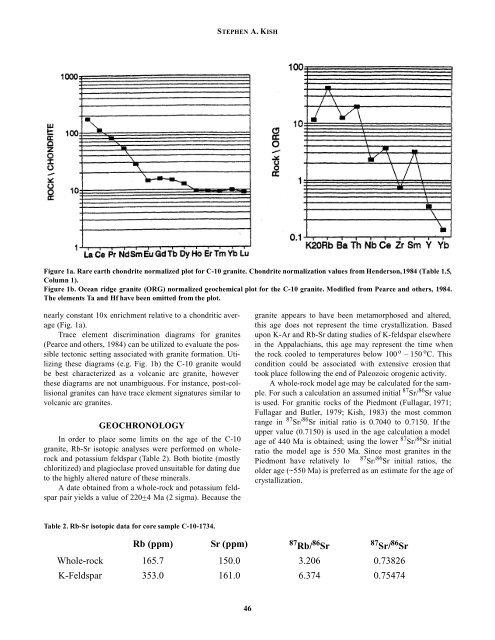Download Guidebook as .pdf (1.8 Mb) - Carolina Geological Society
Download Guidebook as .pdf (1.8 Mb) - Carolina Geological Society
Download Guidebook as .pdf (1.8 Mb) - Carolina Geological Society
Create successful ePaper yourself
Turn your PDF publications into a flip-book with our unique Google optimized e-Paper software.
STEPHEN A. KISH<br />
Figure 1a. Rare earth chondrite normalized plot for C-10 granite. Chondrite normalization values from Henderson, 1984 (Table 1.5,<br />
Column 1).<br />
Figure 1b. Ocean ridge granite (ORG) normalized geochemical plot for the C-10 granite. Modified from Pearce and others, 1984.<br />
The elements Ta and Hf have been omitted from the plot.<br />
nearly constant 10x enrichment relative to a chondritic average<br />
(Fig. 1a).<br />
Trace element discrimination diagrams for granites<br />
(Pearce and others, 1984) can be utilized to evaluate the possible<br />
tectonic setting <strong>as</strong>sociated with granite formation. Utilizing<br />
these diagrams (e.g. Fig. 1b) the C-10 granite would<br />
be best characterized <strong>as</strong> a volcanic arc granite, however<br />
these diagrams are not unambiguous. For instance, post-collisional<br />
granites can have trace element signatures similar to<br />
volcanic arc granites.<br />
GEOCHRONOLOGY<br />
In order to place some limits on the age of the C-10<br />
granite, Rb-Sr isotopic analyses were performed on wholerock<br />
and pot<strong>as</strong>sium feldspar (Table 2). Both biotite (mostly<br />
chloritized) and plagiocl<strong>as</strong>e proved unsuitable for dating due<br />
to the highly altered nature of these minerals.<br />
A date obtained from a whole-rock and pot<strong>as</strong>sium feldspar<br />
pair yields a value of 220+4 Ma (2 sigma). Because the<br />
granite appears to have been metamorphosed and altered,<br />
this age does not represent the time crystallization. B<strong>as</strong>ed<br />
upon K-Ar and Rb-Sr dating studies of K-feldspar elsewhere<br />
in the Appalachians, this age may represent the time when<br />
the rock cooled to temperatures below 100 o – 150 o C. This<br />
condition could be <strong>as</strong>sociated with extensive erosion that<br />
took place following the end of Paleozoic orogenic activity.<br />
A whole-rock model age may be calculated for the sample.<br />
For such a calculation an <strong>as</strong>sumed initial 87 Sr/ 86 Sr value<br />
is used. For granitic rocks of the Piedmont (Fullagar, 1971;<br />
Fullagar and Butler, 1979; Kish, 1983) the most common<br />
range in 87 Sr/ 86 Sr initial ratio is 0.7040 to 0.7150. If the<br />
upper value (0.7150) is used in the age calculation a model<br />
age of 440 Ma is obtained; using the lower 87 Sr/ 86 Sr initial<br />
ratio the model age is 550 Ma. Since most granites in the<br />
Piedmont have relatively lo 87 Sr/ 86 Sr initial ratios, the<br />
older age (~550 Ma) is preferred <strong>as</strong> an estimate for the age of<br />
crystallization.<br />
Table 2. Rb-Sr isotopic data for core sample C-10-1734.<br />
Rb (ppm) Sr (ppm) 87 Rb/ 86 Sr 87 Sr/ 86 Sr<br />
Whole-rock 165.7 150.0 3.206 0.73826<br />
K-Feldspar 353.0 161.0 6.374 0.75474<br />
46













